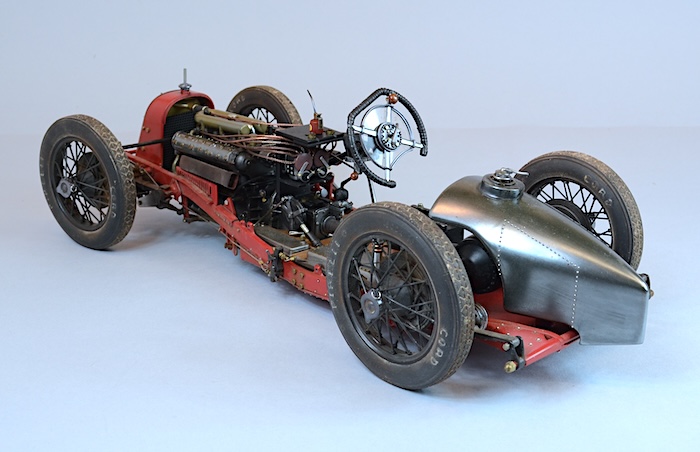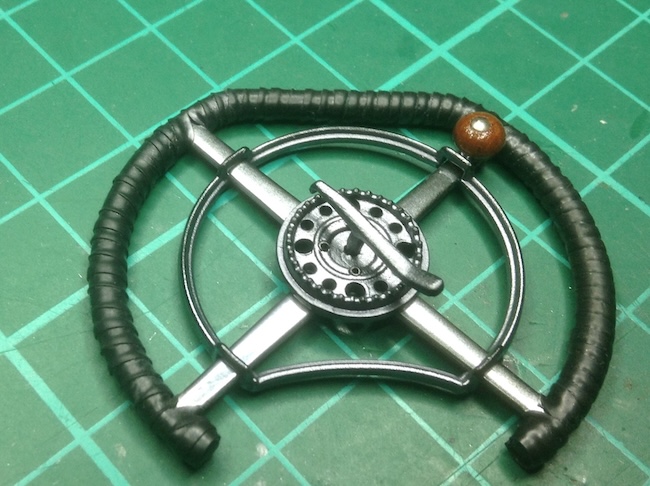
Feature Article with Rafal Sikorski
And just before we get started, here’s a look at how my project turned out…

The 1927 Fiat 806 “Meteorite Engineering” : Striking speed, short life, big impact…and destruction.
Modifications of the ITALERI 1:12 FIAT 806 Grand Prix- the cornerstone to a modern Grand Prix cars.
(Scale Model World 2018: Category and Albion Alloys Trophy winner; Best in Show at Model Kraft, Southern Expo and Chiltern Shows).
Avant-garde in the 1927 Grand Prix season
After the unquestionable achievements of the Fiat Mephistopheles (Mefistofele) during the 1923 season, Fabbrica Italiana Automobili Torino in order to follow a long-lasting dream of the founder, ‘Gianni’ Giovanni Agnelli (to be “the most innovative, successful motor car manufacturer of the day”), in 1927 designed the first in the history of the GP single seat car.
The “806” project team was lead by engineer Tarquilo Zerbi, famously known for his excellent Fiat V12 seaplane engines which were also fitted in a record breaking Macchi Castoldi M.C.72 seaplane.
In effect, T. Zerbi with Alberto Massimino’s assistance, designed a “Tipo 406” 1500 cc. V12 power plant, equipped with a 4 speed gearbox. The Fiat 806 “one seat” endeavour was also pioneering in optimising and minimising in-car space, which can be without a doubt interpreted as a first attempt in applying ergonomics to GP car. These early steps in ergonomics were applied for example to the steering wheel; flattened on the top and bottom to improve control over the car and to improve the driver’s seating space.

(Photo: The first steps in GP car ergonomics; Fiat 806 flattened steering wheel)
Alongside with ergonomics and innovative engine, the Fiat 806 also incorporated groundbreaking chassis design. With significantly lowered centre of gravity, Fiat was evidently far more aerodynamic than Alfa Romeo and Bugatti – major GP opponents at that time.
At this occasion it can be argued that Fiat consciously introduced “aerodynamic rivalry” in the design of Grand Prix cars. Thanks to these innovations applied by the Torino team and combined with lightweight(700 kg dry), the Fiat 806 was capable of reaching speeds of over 140mph. In fact, during the tests at Monza in summer of 1927, the 806 was four seconds a lap faster than the previous lap record holder, Peter Kreis in Duesenberg special.
Also in the same year during the Milan GP at Monza, the 806 won pole position and the entire race (ahead of an Alfa Romeo P2 and a Bugatti T35),and was also applauded for the fastest lap of a day. In the autumn of 1927, Team Torino booked its place in the RAC GP at Brooklands; however the Fiat Team 806’s never made their appearance in the UK.
Despite the great development of the Fiat 806 in the 1927 GP season and good winning prospects for an incoming season, the whole team was withdrawn from Racing (until 1969). Additionally, each of 806’s were dismantled, and all relevant technical data was destroyed to follow Agnelli personal command. The hidden reasons for the above destruction were influenced most likely by B. Mussolini, who ordered Fiat to concentrate their production on military elements.
Double inspiration
The challenging reality of limited information on the subject, (actually there are only a few period photos survived from 1927), alongside my natural engineering fascination in the design innovations integrated into the 806, inspired me instantly, against all the odds, to build an accurate as possible scale replica of this legendary Fiat racer.
Before and during the build, all the technical data and solutions were sourced from the mentioned preserved period photos (marginally), and vastly from model-makers forums.
Many thanks to the Fiat 806 -“Gangshow” build album on britmodeller.com, primotipo.com, and motor-car.net websites and from my always ingenious Colleagues of the Harrow and Barnet Model Clubs.
Lastly, (but very importantly) it has to be said, that visits to the Brooklands Museum, British Motor Museum and the National Motor Museum at Beaulieu, were in this case a supreme source of period GP cars engineering solutions.